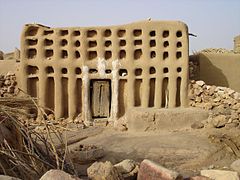

| Part of a serieson |
| Traditional African religions |
|---|
 |
|
Religions |
|
Doctrines |
|
Deities |
|
Sacred places |
|
Education |
|
Priesthood |
|
Relation with other religions |
|
|
|
|

Ahogon is a spiritual leader in a Dogon village who plays an important role in Dogon religion.

A hogon is a religious figure as well as a temporal authority;[1] the hogon may be hereditary or may be chosen from among the village elders—custom varies from place to place. The hogon is always a man. After being chosen, a hogon must pass through several months without washing or shaving. After initiation, he wears a red cap, and a pearl bracelet. Hogon live alone and should be celibate, but a village girl may act as a maid. Nobody should touch the hogon.[2]

The hogon has a key role in village rituals and in ensuring fertility[3] and germination.[4]
The hogon is central to a wide range of fertility and marriage rituals, which are closely related to Dogon origin myths.[5]
The hogon may conduct rituals in the Sanctuaire de Binou, a special building the door of which is blocked with rocks.[6]
According to legend, the first hogon, Lebe, was descended from a nommo. He was eaten by another nommo, and their spirits merged; the nommo vomited out a new Lebe (part human and part spiritual), plus copious liquid which shaped the landscape.[7]
|
Dogon topics
| |||||
|---|---|---|---|---|---|
| People |
|
| |||
| Religion |
| ||||
| History |
| ||||
| Demographic |
| ||||
| Culture |
| ||||